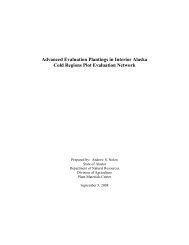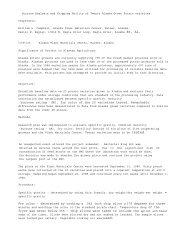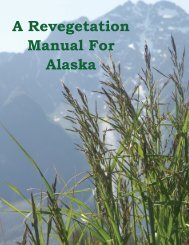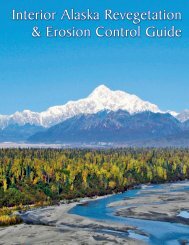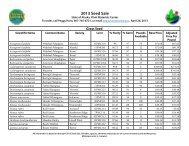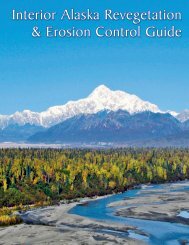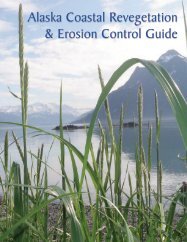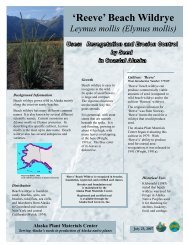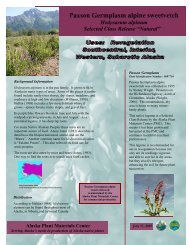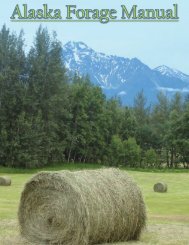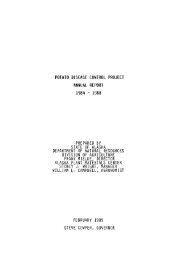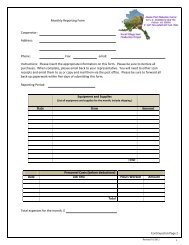Alaska Forage Manual - Alaska Plant Materials Center - State of ...
Alaska Forage Manual - Alaska Plant Materials Center - State of ...
Alaska Forage Manual - Alaska Plant Materials Center - State of ...
Create successful ePaper yourself
Turn your PDF publications into a flip-book with our unique Google optimized e-Paper software.
104<br />
Term<br />
Definition<br />
Biennials: A plant that completes its life cycle in two years.<br />
Bloat:<br />
Boot Stage:<br />
Excessive accumulation <strong>of</strong> gases in the rumen (stomach) <strong>of</strong> an animal.<br />
Growth stage when the sheath <strong>of</strong> the upper most leaf encloses a grass reproductive seedhead.<br />
Bunch Grass: Grass that produces a tufted growth or clump that gradually enlarges as tillers are produced<br />
around the outer edge <strong>of</strong> the tuft. (i.e. Timothy).<br />
Carbohydrate:<br />
Caryopses:<br />
Cellulose:<br />
Compound Leaf:<br />
Cool Season <strong>Plant</strong>:<br />
Carbohydrates consist <strong>of</strong> simple and/or complex sugar molecules that function as readily<br />
available energy. Examples are fructose, glucose, sucrose, starch and hemi-cellulose.<br />
The grain or fruit <strong>of</strong> grasses.<br />
Major skeletal material in the cell wall <strong>of</strong> plants. Provides fiber for diet but minimal nutrition.<br />
A leaf separated into two or more leaflets.<br />
A plant that makes its major growth during the cool part <strong>of</strong> the year, mainly in the spring but in<br />
some localities in the fall or winter.<br />
Crude Protein (CP): The total amount <strong>of</strong> protein, some <strong>of</strong> which is insoluble or non-degradable. Crude protein is<br />
measured in the laboratory by first measuring nitrogen and then multiplying by 6.25.<br />
Cud:<br />
Cultivar:<br />
Culm:<br />
Decreaser:<br />
Decumbent:<br />
Dehiscent:<br />
Digestible Dry Matter<br />
(DDM):<br />
Drought Tolerance:<br />
Dry Matter (DM):<br />
Dry matter Intake<br />
(DMI):<br />
<strong>Forage</strong>:<br />
Elliptic:<br />
Ellipsoidal:<br />
Endophyte:<br />
Ensile:<br />
Friable Soil:<br />
Glabrous:<br />
Glumes:<br />
Haylage:<br />
Hemicellulose:<br />
Food regurgitated from the first stomach to the mouth <strong>of</strong> a ruminant and chewed again for<br />
further breakdown.<br />
The international term cultivar denotes an assemblage <strong>of</strong> cultivated plants that is clearly<br />
distinguished by any characters (morphological, physiological, cytological, chemical, or other)<br />
and when reproduced (sexually or asexually), retains its distinguished characters.<br />
The stem <strong>of</strong> a grass that has elongated internodes between nodes.<br />
<strong>Plant</strong> that is gradually replaced by other species in a stand.<br />
Lying or growing along the ground, but erect at or near the apex <strong>of</strong> some stems.<br />
Splitting open along seed capsule or pod to emit individual seeds.<br />
Digestibility estimated from ADF. The higher the ADF, the lower the digestibility.<br />
The ability <strong>of</strong> a plant to withstand lack <strong>of</strong> rainfall for a portion <strong>of</strong> the year or for extended periods,<br />
sometimes multiple years.<br />
The percent <strong>of</strong> the forage that is not water.<br />
Although it can be determined from feeding trials, it is usually estimated from NDF. The higher<br />
the NDF, the lower the intake.<br />
Herbaceous grasses and legumes available and acceptable to grazing animals.<br />
Longer than wide with rounded ends; rounded oval.<br />
Three-dimensional object that is widest at the middle, tapers to ends <strong>of</strong> the same size, and is<br />
round in cross section.<br />
An organism (fungus, bacteria, nematode, etc...) growing inside <strong>of</strong> a plant.<br />
To store forage as silage.<br />
A soil with a readily crumbled or broken apart surface.<br />
Without hair, smooth.<br />
A pair <strong>of</strong> bracts found at the base <strong>of</strong> a grass spikelet and not containing pistils or stamens;<br />
occasionally one or both glumes are absent.<br />
Product resulting from ensiling forage with about 20-40% moisture, in the absence <strong>of</strong> oxygen.<br />
Polysaccharide fraction existing largely in the secondary cell wall <strong>of</strong> the plant.<br />
Herbaceous: <strong>Plant</strong>s having aerial stems that die back to the soil level each year while the underground parts<br />
remain alive.<br />
Introduced:<br />
Keel:<br />
A species not part <strong>of</strong> the original fauna or flora <strong>of</strong> the area in question, but introduced from<br />
another geographical region through human activity.<br />
Projecting central rib usually found on the back <strong>of</strong> an organ and resembling a boat’s keel.



